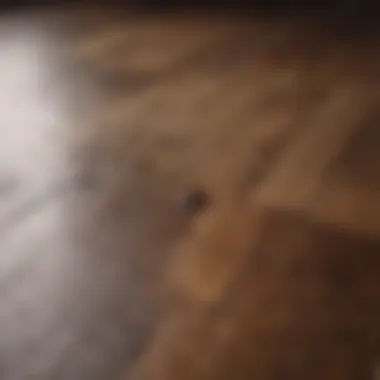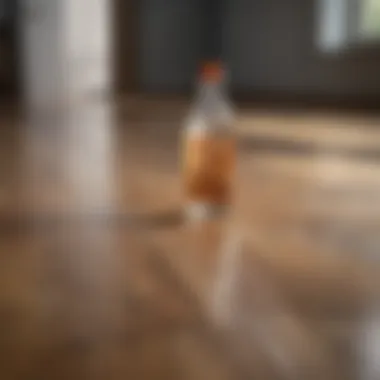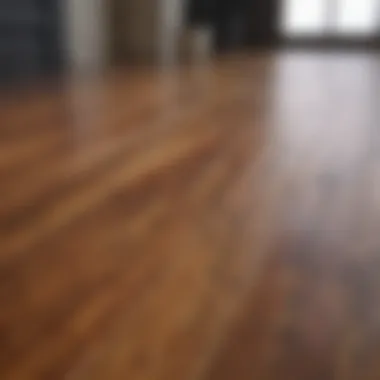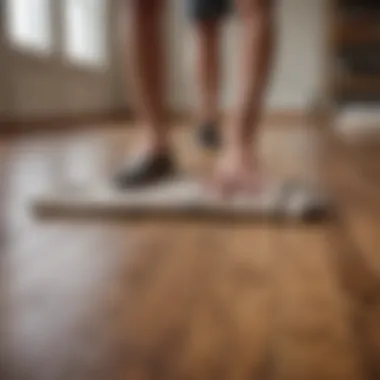Effective Strategies for Removing Stains from Wood Floors


Intro
Maintaining wood floors is more than just routine cleaning; it’s about preserving the integrity and beauty of your home. Wood floors, when cared for properly, can enhance the aesthetic appeal of any space while providing durability over time. However, stains are a common issue that can detract from their charm. From pet-related accidents to spills from daily dining, understanding how to effectively remove these stains is vital. This guide aims to equip homeowners with practical strategies to tackle a variety of stains, ensuring their wood flooring remains stunning.
Understanding the finish of your wood floors is essential for selecting the correct cleaning methods. Different finishes react variously to cleaning agents, so identifying the type of finish you have is important. Stains can be classified into categories like water-based, oil-based, and more, each needing a specific removal approach.
This guide not only discusses targeted cleaning methods but also touches upon strategies for stain prevention. By adopting proactive practices, homeowners can prolong the life of their wood floors, optimizing both beauty and functionality.
"Maintaining wood floors requires knowledge about their care and cleaning, which is critical to ensuring longevity."
In the following sections, we will delve deeper into crucial aspects such as understanding wood finishes, identifying specific stains, and employing effective cleaning techniques. We will conclude with preventive measures to help maintain the splendor of your floors for years to come.
Let’s explore these effective strategies together.
Understanding Wood Flooring
Understanding wood flooring is crucial for anyone seeking to maintain its appearance and functionality. It provides a foundation for addressing issues like stains. Knowledge about wood flooring helps homeowners make informed decisions regarding care and upkeep.
Composition of Wood Floors
Wood floors typically consist of solid wood or engineered wood. Solid wood is made from one single piece of wood, while engineered wood combines several layers. Each layer has its own purpose, often making engineered wood more stable.
- Solid Wood: It tends to be more susceptible to moisture changes, leading to expansion and contraction.
- Engineered Wood: This construction helps it resist warping and shrinking, making it suitable for various environments.
This composition plays a vital role in determining how stains interact with the surface and how they can be treated.
Common Finishes for Wood Floors
The finish on wood floors serves multiple functions, including protecting the wood from damage and enhancing its aesthetic appeal. Common finishes include urethane, oil-based, and water-based finishes.
- Urethane Finish: Known for its durability and resistance to scratches, this finish is often recommended for high-traffic areas.
- Oil-Based Finish: It penetrates deeply into the wood, enhancing its natural beauty but is more susceptible to wear.
- Water-Based Finish: This option dries quickly and has a lower toxicity, making it appealing for indoor use.
Each of these finishes demands different care strategies to effectively remove stains.
Importance of Proper Maintenance
Regular maintenance of wood flooring is essential for its longevity. Failure to care properly can lead to irreversible damage and costly repairs.
- Protective Measures: Regularly cleaning the floors, avoiding harsh chemicals, and using furniture pads can significantly extend the life of the flooring.
- Routine Inspections: Periodically checking for scratches, stains, and wear allows homeowners to address issues before they escalate.
Proper maintenance not only preserves the look of wood floors but also maintains their value over time.
By understanding these basic elements about wood floors—composition, common finishes, and maintenance—it becomes more straightforward to implement effective stain removal strategies later on.
Identifying the Type of Stain
Understanding the specific type of stain present on wood floors is a critical step in the cleaning process. Each type of stain interacts differently with the wood and its finish, requiring tailored methods for effective removal. When you know what you are dealing with, you can choose the right tools and products to ensure the stain is eliminated without harming the flooring. Moreover, improper treatment can lead to discoloration or damage, enhancing the importance of accurate identification.
Water Stains


Water stains often appear as white or cloudy spots on the surface of wood floors. They typically result from spills or moisture that has remained on the surface for too long. These stains can usually be removed without heavy-duty measures. A common method involves using a cloth dampened with a mixture of vinegar and water, followed by gentle buffing. It’s crucial to dry the area thoroughly afterward to prevent future damage.
Oil-Based Stains
Oil-based stains from cooking oil, grease, or furniture polish are particularly stubborn. These stains penetrate deeper into the wood finish, making them harder to remove. One effective approach is to create a paste from baking soda and water, applying it to the stained area. Let it sit for some time before gently wiping it away with a soft cloth. Remember to clean the area afterward with a suitable wood floor cleaner to restore the surface.
Food and Beverage Stains
Food and beverage stains, including those from wine, coffee, or sauces, can vary in severity. Immediate action is often beneficial, as fresh stains are easier to treat. For dried stains, using a soft scrub brush with soapy water can help lift the residue. A natural solution involves mixing lemon juice and olive oil to clean and condition the wood, leaving it looking fresh. However, always test any solution in an inconspicuous area to prevent damage.
Ink and Marker Stains
Ink marks from pens or markers represent more challenging stains. A common approach is to use rubbing alcohol on a clean cloth, dabbing gently on the stain. This method can effectively dissolve the ink without damaging the finish. Be careful not to scrub too hard, as this can lead to further issues. Following this treatment, it’s advisable to apply wood polish to maintain the floor’s shine.
Pet Urine Stains
Pet urine poses unique problems due to the acidity and potential for odor. These stains can also lead to severe damage if not addressed promptly. Start by blotting the affected area with a paper towel to absorb as much liquid as possible. Then, mix white vinegar with water in equal parts and apply it to the stain, letting it sit for a few minutes before wiping it clean. Afterward, using an enzymatic cleaner specifically designed for pet stains can neutralize any lingering odor and help restore the wood's integrity.
Basic Tools for Stain Removal
Stain removal from wood floors is a meticulous process. Having the right tools at hand is essential for achieving the best results. This section discusses the necessary tools and cleaning supplies to efficiently handle various stains, ensuring the beauty and longevity of your wood flooring. Their importance lies not only in their effectiveness but also in minimizing damage to the wood itself during extraction.
Essential Cleaning Supplies
When dealing with stains on wood floors, utilizing appropriate cleaning supplies is crucial. These items not only aid in stain removal but also help in preserving the integrity of the wood finish. Key supplies include:
- Microfiber Cloths: Soft yet durable, these are perfect for scrubbing surfaces without scratching.
- Mild Detergent: A gentle soap can effectively break down grime without harming the finish.
- White Vinegar: Natural and non-toxic, it can work wonders on many stains when diluted with water.
- Baking Soda: This versatile powder can act as a mild abrasive, useful for tougher stains without damaging the wood.
- Isopropyl Alcohol: Excellent for ink and adhesive stains, it evaporates quickly and leaves minimal residue.
Understanding how to utilize these supplies properly will enhance their effectiveness. For example, when using vinegar, ensure it is well diluted to prevent any potential damage from acidity.
Recommended Tools
In addition to cleaning supplies, specific tools are necessary for efficient stain removal. These tools enhance control and effectiveness during the cleaning process. Recommended tools include:
- Soft-Bristle Brush: Ideal for scrubbing without scratching the surface.
- Putty Knife: This tool can help lift stubborn residue, particularly from food stains.
- Steam Mop: For deeply embedded stains, a steam mop can serve as an effective option without chemicals, although care is required to not warp the wood.
- Spray Bottle: Useful for applying solutions evenly to the stained area.
- Protective Gloves: Necessary for keeping hands safe from potential irritants found in cleaning solutions.
Using the correct tools allows for precision and enhances the cleaning process's overall efficiency. Careful consideration of both supplies and tools leads to better outcomes, prolonging the life of your wood floors.
Ensure that all tools are designed for use on wood surfaces to minimize the risk of damage.
Equipping oneself with these essential and recommended tools enables an effective approach to stain removal. With the right preparations, maintaining the elegance of wood floors becomes a far less daunting task.
Techniques for Removing Stains
Removing stains from wood floors is a critical topic for homeowners who want to keep their floors looking pristine. Different types of stains require tailored approaches. Understanding these techniques improves the chances of successful stain removal without causing additional damage. This section elaborates on various methods applied to specific stains, ensuring a thorough grasp of each technique so that readers can apply them effectively.
Method for Water Stains
Water stains often appear as white spots or rings on wood flooring. These marks develop when moisture seeps into the wood finish. The first step is to determine the severity of the stain. If it’s fresh, the problem may resolve itself with a simple drying process. For more persistent stains, use a soft cloth and rub a small amount of mineral oil directly onto the affected area. This approach helps to rehydrate the wood, bringing its natural shine back.
- Dry the area: Ensure no water is remaining.
- Apply mineral oil: Rub gently in a circular motion.
- Clean up: Wipe off excess oil to avoid a greasy look.


If the stain remains stubborn, consider a mixture of equal parts vinegar and olive oil. Apply this solution gently, as vinegar can be abrasive.
Oil Stain Removal Approach
Oil stains can be particularly challenging to remove. These stains often occur in kitchens or living areas where spills happen. The first move is to blot the stain with a clean cloth, avoiding rubbing, which can spread the oil further.
- Blot, don’t rub: Use paper towels or a lint-free cloth.
- Cornstarch option: Sprinkle cornstarch over the stain and let it sit for several hours. This absorbs the oil.
- Wash with soapy water: Afterward, clean the area with a mild dish soap and warm water.
For severe cases, a commercial product like Bona Professional Series may be necessary. These products are specially designed for oil stains without harming the floor finish.
Removing Food and Beverage Stains
Food and beverage stains come in various forms, from sauces to wine. Each type needs a specific method of treatment. The approach often involves three basic steps: blotting, cleaning, and finalizing.
- Blot spills immediately: This minimizes absorption.
- Select appropriate detergent: A few drops of dish soap mixed in water often works well. Use a cloth to apply this solution.
- Rinse and dry: Wipe the area with a clean, damp cloth to remove soap residue, then dry with a towel.
For substances like red wine, applying a paste of baking soda and water can be effective in lifting the stain. Allow it to dry and then sweep off.
Strategies for Ink and Marker Stains
Ink stains, whether from pens or markers, pose unique challenges. They can penetrate more deeply than other stains and may require strong measures. The approach here relies on using rubbing alcohol or hand sanitizer as a primary cleaning agent.
- Apply rubbing alcohol: Dab it onto a clean cloth and press it against the stain.
- Blot effectively: Continue to blot until the stain lifts. Avoid scrubbing, which may damage the finish.
- Wash area with soap: Follow up by cleaning the area with soapy water and drying it thoroughly.
In cases of stubborn stains, consider using Goof Off, a reputable product for sticky situations. Use it sparingly to minimize potential harm to the wood.
Pet Urine Treatment Techniques
Pet stains, especially urine, can be the most troublesome. Not only do they leave stains, but they can also produce a lingering odor. Quick response is crucial in these instances.
- Blot Urine Immediately: Use paper towels to absorb as much as possible.
- Use an enzymatic cleaner: These products are designed to break down uric acid, effectively eliminating stains and odors.
- Rinse and Dry: Clean the area with warm water and allow it to dry. Ensure proper ventilation to eliminate any residual smells.
In scenarios where deep staining occurs, it may be best to sand and refinish the area to restore the wood’s original appearance.
Preventive Measures for Stain Avoidance
Preventive measures for stain avoidance are essential for protecting the integrity and appearance of wood floors. Maintaining a stain-free floor is not just about removing unsightly marks; it extends the lifespan of the flooring, reduces the need for extensive cleaning, and enhances overall aesthetic appeal. Much of the wood floor's beauty comes from its natural grain and finish. Stains can obscure these qualities, making prevention a worthwhile investment.
By understanding and implementing preventive strategies, homeowners can maintain a cleaner environment and avoid the pitfalls of extensive damage that often accompanies neglect.
Using Area Rugs
Area rugs serve as a first line of defense against stains on wood floors. Placing these rugs in high-traffic areas can significantly reduce the wear and tear on the flooring beneath. They act as a buffer, collecting dirt and spills before they reach the wood surface. Choosing rugs that are easy to clean adds to their effectiveness.
When using area rugs, consider the following:
- Material and Thickness: Select rugs with durable fibers that can withstand heavy foot traffic. Thicker rugs can offer added protection by cushioning against impacts.
- Placement: Strategically position rugs in entryways, beneath dining tables, and other locations prone to spills and heavy use.
- Maintenance: Regularly clean and rotate rugs to prevent any mold or grime from accumulating. This also reduces wear on both the rug and the floor below.
- Secure Edges: Ensure that rugs are non-slip to prevent accidents caused by tripping. This is crucial in maintaining a safety measure in addition to stain prevention.
Implementing Regular Cleaning Routines


An effective cleaning routine prevents stains from setting in. Establishing this habit helps maintain the wood floor's condition over time. A clean floor not only looks better but also contributes to a healthier indoor environment.
Here are some steps to consider:
- Daily Sweeping or Vacuuming: Use a soft broom, dust mop, or vacuum designed for wood floors to remove dirt and debris. Regular attention prevents scratching that can emerge from accumulated debris.
- Weekly Damp Mopping: Once a week, use a damp mop with a cleaner specifically made for wood floors. This removes residual dirt and discourages stains from forming.
- Immediate Spill Response: Wipe up any spills as soon as they occur. Use a soft cloth to blot the area rather than rubbing it, which can push the stain deeper.
- Periodic Deep Cleaning: Every few months, perform a deeper cleaning using products that are safe for wood. This process can rejuvenate the floor's finish and remove any stubborn dirt or stains.
Maintaining a proactive cleaning strategy not only eliminates surface dirt but also helps sustain the natural beauty of wood floors.
Long-Term Care for Wood Floors
Maintaining wood floors is not merely about addressing immediate stains; it encompasses a broader approach that ensures the beauty and durability of the flooring over time. Long-term care is crucial for preserving the aesthetics and the overall integrity of these surfaces. A well-kept wood floor enhances the ambiance of a space and can significantly add to the value of a home. Homeowners who recognize the importance of long-term care are often rewarded with floors that look pristine for many years.
Importance of Periodic Refinishing
Periodic refinishing is essential for keeping wood floors looking their best. Over time, even the most carefully maintained floors can show signs of wear from foot traffic and exposure to sunlight. Refinishing involves sanding down the top layers of wood and applying new finish coats. This not only restores the glow of the wood but also provides a protective barrier against future damage.
Some key benefits include:
- Restoration of Original Beauty: Refinishing revives the natural color and elegance of the wood.
- Enhanced Durability: New protective coatings help to defend against scratches and stains.
- Increased Longevity: Regular refinishing extends the life span of the floor, preventing the need for earlier replacement.
- Cost-Efficiency: Investing in periodic refinishing is often more economical than completely replacing the flooring.
In assessing whether to refinish, consider the condition of your floors, the type of wood, and previous maintenance actions. A professional assessment can guide this decision effectively.
Choosing the Right Cleaning Products
Selecting appropriate cleaning products is fundamental in the long-term care of wood floors. The correct products will help maintain luster and prevent damage over time. It is critical to be aware of what is safe to use on your specific floor finish. Generally, here are some guidelines for selecting cleaning supplies:
- Avoid Harsh Chemicals: Products containing ammonia or bleach can damage the finish and the wood itself. Instead, opt for pH-balanced cleaners.
- Eco-Friendly Options: Natural cleaners, like those made from vinegar or gentle soap, can be effective without the risk of harmful residues.
- Manufacturer Recommendations: Always consult the guidelines provided by the floor manufacturer. Different finishes may require specific care.
Using the right products not only helps to clean but also contributes to maintaining the beauty and integrity of the floor. It is advisable to test any new product in a small, inconspicuous area first to ensure compatibility with your flooring.
Maintaining the right care regime and cleaning correctly will significantly increase the durability of wood floors, ensuring they remain a beautiful feature of the home for years to come.
Following these strategies for long-term care will aid in preserving the quality of wood floors. This section of the article aims to inform homeowners about essential practices that will keep their wood flooring looking great while maximizing their investment.
When to Seek Professional Help
The topic of when to seek professional help is crucial for homeowners dealing with wood floor stains. Despite the numerous methods available for DIY stain removal, there are circumstances where the expertise of a professional is warranted. Understanding the limits of personal skill and the specific needs of the wood floor can make a significant difference in preserving the floor's integrity and appearance.
Professional cleaners often possess specialized tools and products that aren't available to the average homeowner. These tools can be effective in removing stubborn stains without causing damage to the wood or finish. Additionally, hiring professionals can save time and avoid the frustration that often accompanies trying to tackle more severe stains.
It's important to weigh the potential costs against the value of the wood flooring. A professional cleaning or refinishing may be an investment worth making, especially if the floor has significant sentimental or monetary value. Often, the results of a professional service can restore the beauty of the floor while ensuring that it remains in good condition for years to come.
Identifying Severe Stains
Determining when a stain is severe involves looking at various factors, including the depth of the discoloration and the type of substance that caused it.
- Persistent discoloration: If a stain remains even after attempting to clean it with standard methods, it can indicate a deeper issue.
- Color change: Dark stains or a change in the wood color may suggest that the finish is compromised or that the wood has absorbed moisture.
- Texture changes: If the surface feels rough or raised, it may be a sign that the stain has penetrated the finish.
- Multiple product attempts: If you have already used various products without success, it is advisable to consult with a professional.
Evaluating these aspects can help homeowners understand when a stain exceeds the capabilities of typical cleaning solutions.
Indicators of Damage Beyond Stains
Beyond what might be categorized simply as a stain, certain signs indicate that damage may be extensive. Homeowners should monitor their wood floors for:
- Cupping or Crowning: If the edges of the boards are raised, this may suggest moisture retention or water damage.
- Cracks: Split or cracked boards can be a sign of long-term structural issues requiring immediate attention.
- Competition of finish: If the finish is wearing away or showing significant signs of deterioration, restoring it may not solely be about cleaning stains but reapplying the finish entirely.
- Warps: Wood that appears warped often requires professional evaluation for replacement or repair.
If any of these indicators are present, it is wise to seek professional help to assess the damage properly and decide on the best course of action.







